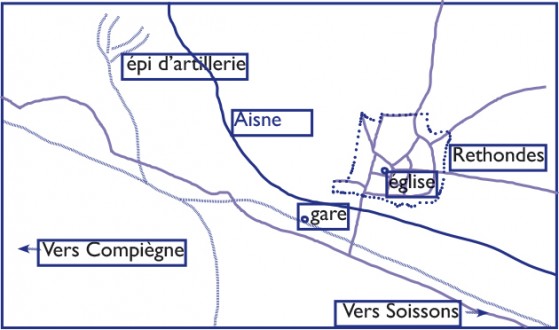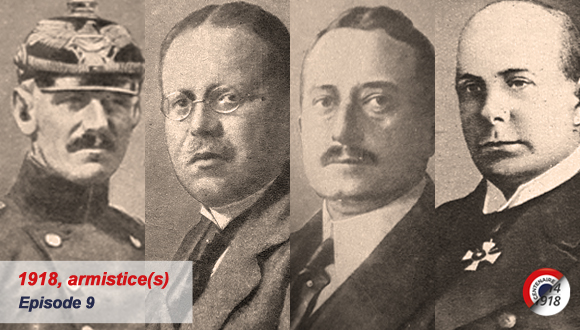Infantry General Erich von Gündell, despite being initially announced, was ultimately withdrawn from the delegation. It was thus the Secretary of State for Foreign Affairs, Mathias Erzberger, Ambassador Count von Oberndorff, General von Winterfeldt, former military attaché in Paris who spoke French, and the ship’s captain Ernst Vanselow who signed the armistice. Alongside them were Cavalry Captain von Helldorf, liaison officer and interpreter, Chief of Staff Geiger, two housekeeping officers and a civilian servant. © Paris, musée de l’Armée.
 Diagram of the meeting place. The village of Rethondes is located in the valley of the Aisne, on the right bank of the river. The station, called Rethondes, is located on the left bank of the Aisne, in the forest of Compiegne, on the railway of Compiegne in Soissons © Paris, musée de l’Armée.
Diagram of the meeting place. The village of Rethondes is located in the valley of the Aisne, on the right bank of the river. The station, called Rethondes, is located on the left bank of the Aisne, in the forest of Compiegne, on the railway of Compiegne in Soissons © Paris, musée de l’Armée.
“Allo Eiffel, allo Eiffel… The German High Command on the order of the German Government, to Marshal Foch. The German Government having been informed by the President of the United States that Marshal Foch had been vested with powers to receive the accredited representatives of the German Government and to inform them of the conditions of the armistice (…)”.
The request for Armistice
“Allo, Eiffel…”
On October 5, a telegram, intercepted and deciphered by the French, sent by the new chancellor (since October 1) Max de Bade, through the Swiss government to American President Wilson, proposes to immediately conclude a general armistice on land, at sea and in the air, and to summon the belligerents with a view to peace negotiations. At Clemenceau’s request, Foch prepares a draft text and convenes the Allied army commanders. The Moudros armistice was signed at the end of October, at Villa-Giusti on 3 November (see panels 5 and 6). On 7 November 1918, at midnight thirty, Maurice Hacot, a corporal assigned to the radio-telegraph centre of the Eiffel Tower, received the request for an armistice, in Morse form, issued from Spa in Belgium.
A place
Initially, some called for Berlin, others for Versailles. Foch, even before having received the radiotelegram from the German command, has already chosen a route for the plenipotentiaries. He replied: “They must come before the French outposts by route de Chimay, Fourmies, La Capelle and Guise. Orders are given to receive them and take them to the place set for the meeting. On 6 November, Foch entrusted the DTMA, the Department of Military Transport to the Armed Forces, with the task of finding a place accessible by train, close to the front line and such that the plenipotentiaries would not to be exposed or disrupted. The sous-chef de service Pierre Toubeau and his team discovered, 2 km from the Rethondes station, in the forest of Compiègne, a heavy artillery fire spur fitted out in 1916, left to abandon and not indicated on the map, near the Francport crossroads. After approval from the General Staff, the site was quickly refitted for use. Apart from the Foch headquarters and the DTMA team, only Pétain and Clemenceau were informed of the chosen location. Another team is responsible for assembling a train for the German delegates, including a wagon designed for Napoleon III, decorated with the Imperial eagle and bee.



Ajouter un commentaire